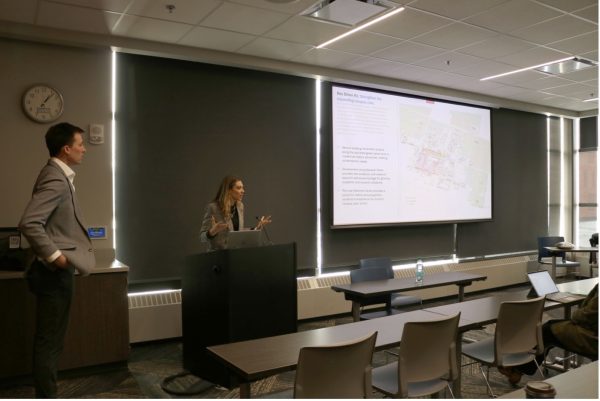SDSU ‘Industry cluster’ study looks at I-29 corridor
July 23, 2011
Researchers at South Dakota State University are studying the state’s Interstate Highway 29 corridor to learn what “industry clusters” exist already, and what related industries would complement them to drive economic growth.
Carol Cumber, a professor in SDSU’s Department of Economics, is defining and analyzing industry clusters with master’s degree student Joshua Warne. Their project has won the Chicoine Family Excellence in Economics Fund award of $5,000 for 2011-2012, one of several donor-funded programs in economics and management that are taking shape as South Dakota State University’s Department of Economics responds to emerging needs in the state and regional economy.
The I-29 Task Force, a group that commissioned an earlier study by a consulting group, is also supplying $5,000 toward the project. Cumber and Warne are building on the report from that study, “Pressing the Advantage: A Regional Growth Strategy for the I-29 Corridor,” prepared by Regional Technology Strategies Inc.
More than 75 business owners, community leaders, economic development directors, university people and industry leaders make up the I-29 Task Force.
“I think it’s important to recognize how proactive and forward thinking they are being, especially the economic development directors,” Cumber said. “The traditional business model is that you bring in as much business for your community as you can, and you’re in a competitive mode with other communities. They’re trying to look beyond this and say that if we can have a strong region, it’s going to help all of our communities. So they’re trying to embrace a collaborative instead of competitive model.”
Cumber and Warne are still early in the study process. They’re now defining the clusters and the value chain — identifying the suppliers, their products, and downstream customers. Once they have done that, they will interview economic development coordinators, business owners, and industry leaders to find out where gaps may exist. Cumber and Warne said that is where the employment potential and business growth potential is — in identifying and filling those gaps.
I-29 physically passes through 11 counties. Given the rural nature of South Dakota, several additional cities and counties are also considered to be a part of the I-29 corridor. This was determined based upon their relatively close proximity to and frequent use or dependence upon Interstate 29. In total, the I-29 corridor includes 20 counties, some stretching as far west as 70 miles away. Counties to the east of I-29 are bordered by the state of Minnesota.
“The theory of industry clusters is that there is a group of industries that perform similar or supporting activities. They produce products or services that are complements so that suppliers would gather in that same area to supply the inputs that they put into those products, they employ the same types of manufacturing processes, or they need the same types of labor skills. The idea is that they cluster in the same area,” Warne explained. “So when we look at the region we’re saying, OK, we have this cluster, we have a few strong industries. Are we seeing these other supporting, complementary industries clustering here as well? And if not, is there something we could do to improve the strength of that cluster by bringing in a supplier to support those existing businesses and industries, or helping them develop downstream markets so that they have an expanded market to supply their product to? The whole idea is to strengthen the cluster.”
Warne’s goal is to gather data through summer and fall of 2011, disseminate what he and Cumber learn to economic development leaders and others in the I-29 corridor in spring 2012, and be finished with the thesis for his master’s degree in economics by May 2012.
The study area will follow I-29 corridor within the boundaries of South Dakota, taking into consideration communities that clearly rely on the I-29 corridor, Cumber said. Warne added that even smaller communities that don’t typically dedicate staff and resources to economic development might benefit.
“I think one of the things that major communities have learned is that not only is this regional economic development important for them, but it will also help support and sustain rural growth in some of these small communities,” Warne said. “Some of these smaller communities don’t have the funds to hire an economic development coordinator, or to market their community the same way a Watertown, Brookings, or Sioux Falls does, so this joint regional effort may present opportunities to some of the smaller communities as well.”
The Chicoine Family Excellence in Economics Fund was set up to advance and strengthen the teaching, research and outreach program in the Department of Economics. SDSU President David Chicoine of the class of 1969 and three other of the Chicoine siblings — Jeffrey (’68), Brian (’83), and Nicole (’90) — graduated from the SDSU Department of Economics. The Chicoine Family Excellence In Economics Fund is established as a tribute to Roland and Evelyn Chicoine and as a small token of gratitude to the faculty and administrators of the SDSU Department of Economics.
Story and photo courtesy of sdstate.edu/news





















